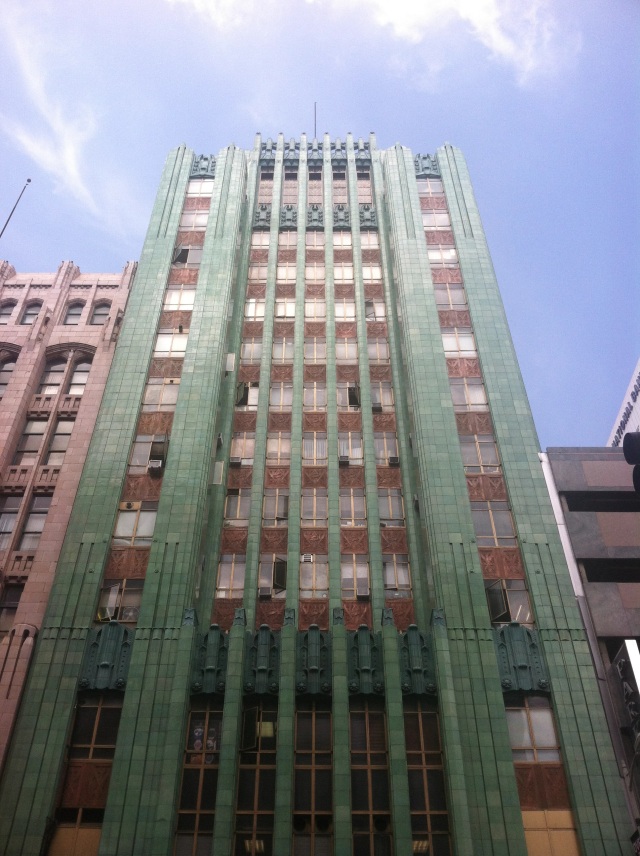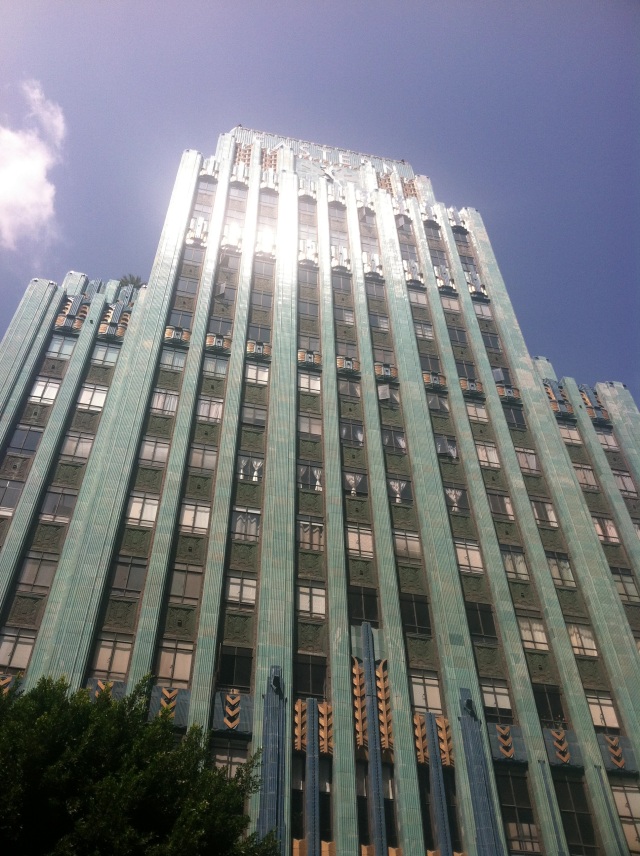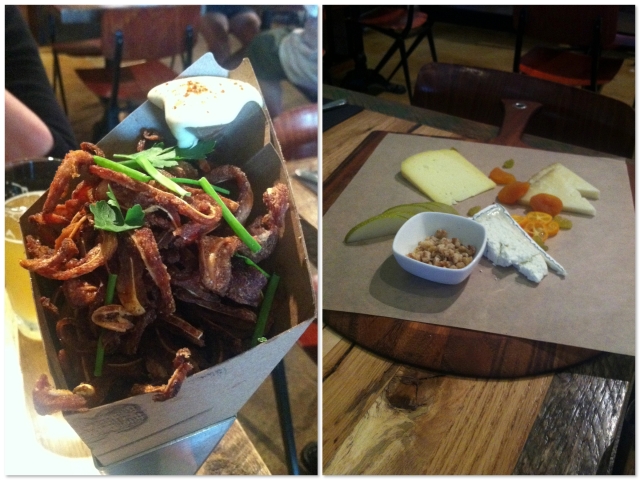Blowhard, Esq. writes:
Recently, I attended a walking tour offered by the Los Angeles Conservancy, a charitable organization tasked with “preserving and revitalizing greater Los Angeles’ architectural heritage.” (Don’t laugh.) These tours are offered every weekend of such places as the Victorian homes of Angelino Heights, Union Station, and the Biltmore Hotel. Noir fan that I am, I opted for the Art Deco tour.
We started in Pershing Square at 10am on a Sunday.
Designed by Ricardo Legorreta, the purple pylons are supposed to evoke mountains and water flowing to the orange spheres that are meant to represent L.A.’s citrus industry. Hey, crazy idea: why not just plant citrus trees instead of some goofy abstraction? It’s only been this way since the early 90s but, shock of shocks, the design has never been popular. A redesign is in the works.
For the sake of comparison, here’s what the area looked liked from the 20s until the early 50s.
No joke, they tore that out so they could build an underground parking garage. (Pausing so can shake your head or facepalm.) Apparently the park was a notorious spot for homosexual hook-ups. Hart Crane (who was himself gay, it should be noted) observed, “The number of faggots cruising around here is legion.”
But we’re here to talk about Art Deco, not anonymous gay sex. (I’ll save that for another post.) Although it had roots in pre-WWI Europe, the style gained prominence after a 1925 trade show in Paris dedicated to the applied arts. Camille Paglia notes that while the style catered to the elite in Europe, “[i]n the United States in the 1930s, Art Deco became a more populist style favored by businesses and public works commissions,” not to mention Hollywood “from Cedric Gibbons‘s chic set designs to Busby Berkeley’s kaleidoscopic dance routines.” Art Deco artists and architects drew from a number of styles, including Greek, Roman, Gothic, and Pre-Colombian art. King Tut’s tomb had been recently discovered in 1922, so there is a pronounced Egyptian influence.
Title Guarantee Building, Parkinson & Parkinson, 1929-1931
Designed by the father-son team of John B. and Donald D. Parkinson who are also responsible for Union Station, L.A. City Hall, the L.A. Coliseum, and the Bullock’s Wilshire Building. Creators of some of L.A.’s most beloved structures, they were skilled at many styles apart from Art Deco including Beaux Arts, Mission Revival, and Romanesque Revival. Pretty significant local figures, if you ask me, yet while researching this post I couldn’t find a single book or museum retrospective devoted to their work. Originally a commercial building, today the Title Guarantee is fancy lofts.
Click on the photos to enlarge.
SCE Company Building, Allison & Allison, 1931
The headquarters of Southern California Edison, this was appropriately the first all-electric building in Los Angeles. The firm responsible for this building also designed UCLA’s Royce Hall.
Oviatt Building, Walker & Eisen, 1927-1928
A haberdasher, James Oviatt would take annual trips to Europe to stock his store that, at the time, was the most expensive men’s clothing store in Los Angeles. In 1925 he attended the Exposition Internationale des Arts Décoratifs et Industriels Modernes in Paris and hired a number of designers to decorate his store.
Sun Realty Building, Claud Beelman, 1931
Beelman, like the Parkinsons, seems sorely in need of more recognition. This master’s thesis from USC looks interesting. One of his works, the Garfield Building, has been abandoned since 1991.
A couple of notes about the construction. These building are, for the most part, concrete covered in a very thin terra cotta skin that’s not even an inch thick. Furthermore, most are no taller than 150 feet as that was the maximum allowed for by the city’s building codes. If an architect wanted to exceed that height, the structures above 150 feet had to be unoccupied, e.g. house electrical or elevator equipment only. The city restricted building heights to prevent the “canyonization” effect from the construction of large skyscrapers one could see in Chicago and New York. They didn’t want to block the famous California sunshine.
Eastern Columbia Building, Claud Beelman, 1930
This building took nine months to erect. As the docent pointed out, nowadays, an environmental impact report will take you at least a year. The building originally housed two retail stores, Eastern and Columbia Outfitting, whose motto was, “You supply the bride, we’ll supply the house.”
The building’s main entrance. Even with a washed-out iPhone snap, it’s still spectacular.
By the end of WWII, Art Deco faded from popularity, giving way to Modernism and the International Style. Paglia writes:
After it became passe in the 1940s, gay male collectors kept Art Deco alive as “camp,” laying the groundwork for the style’s later revival and its current high value at auction. But Art Deco is still underrepresented in major museums and minimized or ignored by many art historians, partly because it does not support the ruling paradigm of art as leftist resistance. On the contrary, Art Deco was promptly adopted for political posters and public architecture by fascist regimes in Germany, Italy, and Russia.
Thus Art Deco remains, like Victorian Academic art, a style that is enormously popular with the public yet derided and dismissed by the critical establishment.
* * *
The tour was two and a half hours of walking, so we worked up an appetite. Luckily, we finished right next to UMAMIcatessen, the latest restaurant in the Umami Burger empire. How about some shredded pig ear and a cheese plate?
Finally, a trip to downtown L.A. ain’t complete without paying homage to Santa Muerte.






























How gullible do you have to be to buy those atrocious megaliths and spheres as mountains and orange groves?
LikeLike
Contempo public art, eh? What a scam. Deserves an indignant/amused blogposting of its own.
LikeLike
There are some awful/great examples of public art near my work. I’ll round up some pics for a later post.
LikeLike
Another fine place for Art Deco is Napier, on the North Island of NZ – a delightful wee spot. And excellent local wine too.
LikeLike
Art fucking Deco, man…
Few other styles strike the eye with such power. They may feature bold contrasts of texture and color (if you’re lucky), but with large buildings, there are only so many textures and colors you can exploit. Where the architect has the most room for variety is in the scale of the elements. Just look at how many different sizes there are across the individual components, and juxtaposed and interwoven for maximum contrast. They’re orders of magnitude in difference, like a fractal pattern.
Sometimes if there’s variety in scale, the different scales are grouped together, like the large-scale things near the bottom, moving gradually toward the tiny-scale things near the top. That looks nice too, but it only creates a few regions of high contrast, where one scale ends and the next one begins.
The elements in an Art Deco building are arranged more like a tartan pattern than a gingham pattern. Seems like such a minor choice. Yet it packs a punch in a way that the uniform-scale patterns cannot.
LikeLike
The total lack of an auteur’s signature puts Art Deco in with other great styles, like the Regency / Empire period in architecture but especially in furniture and interior design. (Lots of ancient revival and exotic influences there, too.)
For the non-verbal arts, there should be absolutely nothing to “get.” The works are good or bad judged by their visceral impact. Some wannabe “starchitect” laboring to stamp his mark into the work only gets in the way. It activates the logical / rational / propositional lobes of the brain, preventing an immediate gut response of delight and wonder.
The anonymity of Art Deco designers and architects, and the fact that many were one-hit wonders, testifies to the style’s absence of pretentiousness. Unpretentious, one-hit wonder, “who did that, again?” — sounds like a collection of ’80s hits.
I’d say they go further than trying to reach the audience at a popular level — any hack can pull that off. Rather, they connect with the human animal at a primitive level. It feels prehistoric or archaic, not classical and introspective. No studied, self-aware emotions shown on any of the bas relief sculptures.
And yet the patterns look so unfamiliar and the building techniques so modern as to appear futuristic. Futuristic primitivism — another touchstone it shares with ’80s new wave music.
LikeLike
Well, with the gushing out the way, one major nit to pick — Art Deco started to die off by the mid-1930s, and was basically dead by the late ’30s. It was a Jazz Age style, not a mid-century style.
The “Streamline Moderne” style that took its place had none of the variety in scale of details. Indeed, its defining distinction against Art Deco is the Puritanical scrubbing off of all ornamentation. The palette becomes bleached of color. And the earlier, heady juxtaposition of primitive and futuristic loses out to a gullible, eagerly optimistic futurism. “Behold: the world of tomorrow, today.”
At least it’s still anonymous and lacking in starchitect appeal, but it’s clearly already moving in the direction of We Have Something Important To Say. It’s so stark and silent, like some pretentious person parading around in severe white clothing, daring you to ask him what the concept is behind his outfit.
That’s the stuff that the Fascists and other Totalitarians felt such a deep connection with. It wasn’t so far apart from the International Style favored by the technocrats and Corporatists in the democratic nations. All of those guys were part of the starched sobriety of the mid-century, just the total opposite of the footloose and fancy-free folks from the Jazz Age.
LikeLike
Funny comment on this post from reddit: “I love this stuff. I studied architecture in school and really enjoy the subject. I write greeting cards for a living now.”
LikeLike
As for “cypress trees” replacing cypress trees, I couldn’t help but think of this from the late great Guy Davenport: “Guy Davenport, “Making It Uglier to the Airport,” in Every Force Evolves a Form: Twenty Essays (San Francisco: North Point Press, 1987), pp. 156-165 (at 161)” [via Laudator Temporis Acti]:
“Poland survived the Second World War better than my hometown in South Carolina. Main Street has rotted into a wasteland. Gracious old homes came down to make way for used-car lots, tacky little finance companies, and drive-in hamburger pavilions. The seven ancient oaks that stood around the house where Thomas Wolfe’s sister lived fell to the power saw, and the house itself, deporched, hoked up with neon and Coca-Cola signs, was islanded in a desolation of tar paving and converted into an eatery called, with that genius of the destroyer for taunting, The Seven Oaks.”
Imagine if starchitect PTB-lickspittles realized–really realized that they’re working for the same kind of people they spend their working hours crapping all over…well, imagine it.
LikeLike
Pingback: Nevada City and Architectural Theory | Uncouth Reflections
Pingback: Ronco’s Amazing Umami-at-Home! | Uncouth Reflections
Pingback: Linkage | Uncouth Reflections
Pingback: Architecture Du Jour | Uncouth Reflections
This building took nine months to erect. As the docent pointed out, nowadays, an environmental impact report will take you at least a year.
Oh, progress!
LikeLike
Pingback: Architecture and Color, Once Again | Uncouth Reflections
Pingback: Edges, Pointiness, Minimalism and Public Seating | Uncouth Reflections
Pingback: Why Wasn’t I Invited? | Uncouth Reflections
Pingback: Architecture Du Jour: Celebration, Florida | Uncouth Reflections